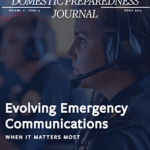- Articles, CBRNE, Critical Infrastructure, Emergency Medical Services, Fire, Hazmat, Law Enforcement, Military, Public Health, Transportation
- Michael Ross
There is a growing industry of “realistic active shooter” drills. Many are focused on teaching participants how to “survive” an event. These drills involve imitation attacks, physical confrontations, fake weapons, and simulated deaths. Some of these drills have led to actual shootings, people being locked in closets or storage rooms, and deployment of tactical squads who were not pre-briefed or included on the drill. These drills do not promote resilience.
Realistic active shooter drills could result in severe commercial and educational disruption, secondary trauma and toxic stress, and even injuries and deaths. Statistics show that trauma is already pervasive throughout society: one in five children have witnessed violence in their families or neighborhoods within the past year. Drills do not need to add to already-existing societal violence.
Mental Health’s Societal Impact
The prevalence of mental health needs within communities needs to be acknowledged and taken into consideration when designing planning drills. According to the National Alliance on Mental Illness (NAMI), mental health related issues are widespread across communities:
- One in five U.S. adults experience mental illness each year;
- One in six U.S. youth aged 6-17 experience mental health disorders each year; and
- Suicide is the second leading cause of death among people aged 10-34.
According to a 4 September 2019 New York Times article (“When Active-Shooter Drills Scare the Children They Hope to Protect”), numerous “realistic active shooter” drills and scenarios have had documented outcomes that were psychologically damaging and traumatic for participants. During a drill in June 2018 held at Short Pump Middle School in Glen Allen, Virginia, school officials staged an unannounced active-shooter drill featuring multiple fire alarms, loud noises, and unseen people jiggling the handles of classroom doors. Believing it was a real attack, students wept and sent “goodbye texts” to parents.
The number, style, and purpose of active shooter/assailant drills in schools has received more attention as the number and lethality of shootings has increased. Thirty-nine states currently require active shooter or lockdown drills. Although some states require parental notification before or after an event, none require a pre-assessment of how the training is being conducted, or how they may trigger negative outcomes. Administrators and parents have questioned the likelihood of such drills triggering past trauma or inducing new trauma in children.
Being involved in an actual active shooter event is still significantly less likely than being struck by lightning. Yet, even if an actual active shooter event is extremely unlikely to happen, communities still need to be prepared. Since the act of preparation itself is not disturbing or traumatic, informed exercises incorporate established baseline competencies for drill organizers around mental health and psychological trauma. An evidenced-driven approach would then leverage scientific knowledge to create a sense of calm and an opportunity to learn.
Interdisciplinary Lessons Learned
Preparation for building fires occurs without setting fires. Preparation for nuclear attacks and airplane evacuations occur without dispersing radiation or jumping from planes. Fire, hazardous materials, and airline industries have developed systems that work, and principles that can be universally applied. For example, passengers sitting in exit rows on airplanes understand that they will need to work with trained flight attendants during an evacuation, with emergency lights indicating exit routes. In a building fire, automatic doors will suppress smoke or flames when the alarms or operators recognize a danger. Such proven safety systems assume that the best decisions are made when people are not traumatized.
Realistic and repetitive active-assailant training was conceived for military and law enforcement purposes. The more realistic the training, the better it is for soldiers and police. However, this does not apply to a civilian population, which is generally untrained in handling toxic stress and exposure to potential trauma.
The focus needs to be on avoiding the creation of psychologically traumatic events and ensuring training effectiveness when it is critical. Indeed, the two cannot be de-coupled – effective training is non-traumatic. Traumatizing people when they are being “trained” to save themselves and others could lead to these same people being less capable of performing when needed during an actual event. People who experience traumatic events are three times more likely to be absent from work, and 15 times more likely to commit suicide. The purpose and conduct of safety and preparatory drills should reduce, rather than add to, these trauma statistics.
Despite many efforts to move toward parity in mental and physical health and treatment of the “whole human,” the focus of drills remains on mitigating physical damage and injury. Ensuring that all drills are trauma-informed is a first step to motivate change that comprises wide-ranging and long-term benefits.
The Four Rs
A trauma-informed approach considers the biological, sociological, neurochemical, and psychological impacts of toxic stress and trauma on individuals, families, and communities. Trauma-informed drills acknowledge the prevalence of trauma histories already within society and avoid additional stress or triggers for the individual and the group.
At the heart of a trauma-informed approach are the fours Rs:
- Realize the widespread impact of trauma and understand potential paths to resilience and resistance.
- Recognize signs and symptoms of toxic stress and trauma in participants during all phases of engagement.
- Empower communities to respond to toxic stress and trauma by providing foundational knowledge about trauma.
- Enhance grit and encourage success by selecting approaches that actively resist re-traumatization.
Numerous professional organizations and associations have now developed standards and protocols for conducting school safety drills. The National Child Traumatic Stress Network has issued guidelines, and the National Association of School Psychologists has described approaches to mitigating the psychological effects of lockdowns.
To avoid triggering traumatic stress when planning for events that are high consequence but low occurrence (such as an active shooter), observations of violence in all arenas must be considered. An entire generation has grown up since the Columbine shooting in 1999. This generation has seen what was once unthinkable – theaters, concerts, churches and synagogues, factories, and government offices becoming the locations for mass murders. Locations formerly considered sanctuaries from other life issues are now potential sites for disaster. Occupants must now prepare to live, work, and worship in these locations, without needlessly experiencing fear and traumatic stress.
Facilities across the country – including but not limited to schools, factory floors, places of worship, and recreational spaces – face a variety of threats every day. Too many people already live with toxic and traumatic stress, yet participation in exercises and drills is still critical for fully and effectively responding to active shooter threats. Therefore, the best approach for developing preparedness and resilience trainings does not involve the triggering or exacerbation of mental illness and traumatic stress.

Michael Ross
Michael Ross, MSW, LCSW, is on the faculty at Indiana University School of Social Work. He is a licensed clinical social worker whose clinical focus is evidence-based modalities for the treatment of trauma and the development of resilience. He has expertise in system transformation, disaster response, mental health policy, countering violent extremism, and community-based research. He currently works in education and policy in Indiana and can be contacted at Micharos@IU.edu.
- This author does not have any more posts.






